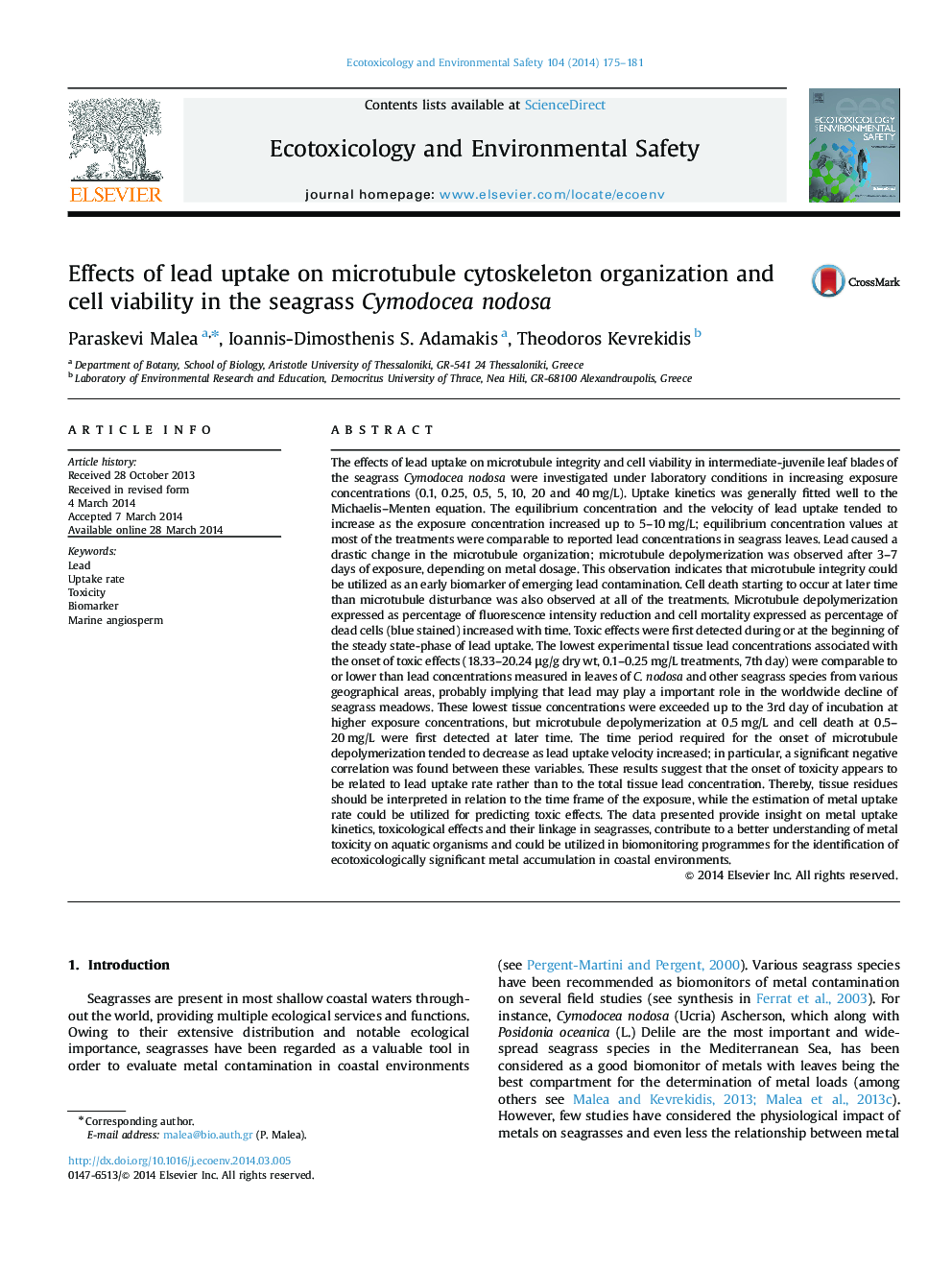| کد مقاله | کد نشریه | سال انتشار | مقاله انگلیسی | نسخه تمام متن |
|---|---|---|---|---|
| 4420135 | 1618959 | 2014 | 7 صفحه PDF | دانلود رایگان |

• The Michaelis–Menten equation satisfactorily described the kinetics of Pb uptake.
• Pb depolymerized MTs after 3–7 days of exposure, cell death occurred at later time.
• Toxicity appeared to depend on Pb uptake rate rather than on tissue Pb content.
• MTs can be used as biomarker of Pb stress and uptake rate for predicting effects.
The effects of lead uptake on microtubule integrity and cell viability in intermediate-juvenile leaf blades of the seagrass Cymodocea nodosa were investigated under laboratory conditions in increasing exposure concentrations (0.1, 0.25, 0.5, 5, 10, 20 and 40 mg/L). Uptake kinetics was generally fitted well to the Michaelis–Menten equation. The equilibrium concentration and the velocity of lead uptake tended to increase as the exposure concentration increased up to 5–10 mg/L; equilibrium concentration values at most of the treatments were comparable to reported lead concentrations in seagrass leaves. Lead caused a drastic change in the microtubule organization; microtubule depolymerization was observed after 3–7 days of exposure, depending on metal dosage. This observation indicates that microtubule integrity could be utilized as an early biomarker of emerging lead contamination. Cell death starting to occur at later time than microtubule disturbance was also observed at all of the treatments. Microtubule depolymerization expressed as percentage of fluorescence intensity reduction and cell mortality expressed as percentage of dead cells (blue stained) increased with time. Toxic effects were first detected during or at the beginning of the steady state-phase of lead uptake. The lowest experimental tissue lead concentrations associated with the onset of toxic effects (18.33–20.24 μg/g dry wt, 0.1–0.25 mg/L treatments, 7th day) were comparable to or lower than lead concentrations measured in leaves of C. nodosa and other seagrass species from various geographical areas, probably implying that lead may play a important role in the worldwide decline of seagrass meadows. These lowest tissue concentrations were exceeded up to the 3rd day of incubation at higher exposure concentrations, but microtubule depolymerization at 0.5 mg/L and cell death at 0.5–20 mg/L were first detected at later time. The time period required for the onset of microtubule depolymerization tended to decrease as lead uptake velocity increased; in particular, a significant negative correlation was found between these variables. These results suggest that the onset of toxicity appears to be related to lead uptake rate rather than to the total tissue lead concentration. Thereby, tissue residues should be interpreted in relation to the time frame of the exposure, while the estimation of metal uptake rate could be utilized for predicting toxic effects. The data presented provide insight on metal uptake kinetics, toxicological effects and their linkage in seagrasses, contribute to a better understanding of metal toxicity on aquatic organisms and could be utilized in biomonitoring programmes for the identification of ecotoxicologically significant metal accumulation in coastal environments.
Journal: Ecotoxicology and Environmental Safety - Volume 104, June 2014, Pages 175–181